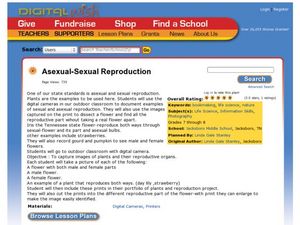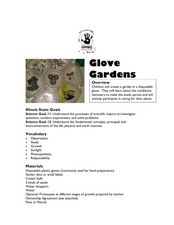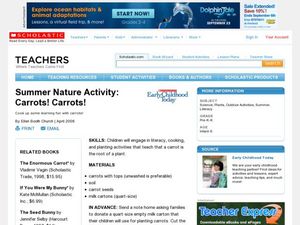Curated OER
Plants vs. Animals
Students discuss the differences they can see between examples of animals and plants. In this science instructional activity, students draw or write what they have discussed about the examples. Students go on a nature walk to look...
Curated OER
How are Seeds Alike and Different?
Second graders examine the seeds in fresh fruit. In this seeds lesson, 2nd graders view different seeds and tell how they are alike and different. Students separate the seeds into groups according to their characteristics.
Curated OER
Asexual-Sexual Reproduction
Eighth graders examine the reproductive organs of plants. In this plant reproduction instructional activity, 8th graders identify the reproductive organs of different plants using a digital camera. Students create a plant portfolio of...
Curated OER
Plant Needs
Students explore the needs of plants. In this plants biology lesson, students work in groups to perform an experiment with tomato plants. Each group records observations in a journal, takes pictures, and interprets the results of...
Curated OER
What is Cacao?
Students use the Internet to learn about the cacao plant. In this plants lesson, students complete a KWL chart on chocolate, learn about cocoa plants and discuss the parts of a plant. Students use the Internet to learn how the cacao...
Curated OER
A Growing Success
Students create a multimedia presentation as a culmination of a plant unit. In this hyperstudio lesson, students research from assigned sites and create a Hyperstudio stack. Students write a cinquain.
Curated OER
Taking in Water and Minerals
Students conduct an experiment. In this plants lesson plan, students conduct an experiment in order to understand how liquid passes through a plant. They use balloons suspended from the classroom ceiling.
Curated OER
Watch Me Grow
Learners observe that plants need air, food, light, and water to survive. In this plant biology lesson, students observe the growth and development of two plants, one is the control plant and the other is denied either air, water, or...
Curated OER
3rd grade life science
In this life science activity, 3rd graders answer multiple choice questions about plants, birds, habitats, and more. Students complete 20 questions.
Curated OER
Fun with Plants: Seeds Are Scattered in Many Ways
In this seeds instructional activity, students collect 6 different types of seeds and test them to see how they travel. Students list the ways their seeds traveled, name the plants and then draw a picture of each seed. Students answer 1...
Curated OER
Plants are Growing and Changing
Learners explore living things. In this agriculture activity, students read the book A Tree is a Plant and participate in an experiment to explore the patterns of change in living things. Learners continue to observe the plant throughout...
Curated OER
Glove Gardens
Students investigate how seeds sprout. In this scientific inquiry lesson, students make predictions on which seeds will grow the fastest and observe the seeds over a period of time. Observations are recorded into a journal.
Curated OER
Learning About Plants- Flowers for a Special Occasion
Students explore the parts of plants and discover that plants need to grow. For this plant lesson, students discuss the parts of the plant and plant petunias. Students can share their plants with friends or families.
Curated OER
Watermelon Graphing
Students discover bar graphs. In this primary math lesson plan, students identify the parts of watermelon seeds and other seeds. Students learn the proper names and common names which refer to the parts of the seeds as they create a bar...
Curated OER
Planting
Fifth graders study the parts of a plant and how they live and grow. In this plant growth lesson plan, 5th graders investigate the processes that plants go through to produce oxygen and release moisture. Diagrams, images, and background...
Curated OER
Classifying Plants and Insects
Art and science come together in a lesson based on Flower Still Life by Ambrosius Bosschaert the Elder. Learners classify plants and insects in the painting by color, leaf shape, size, reproduction, and season of bloom.
Curated OER
How Plants Spice Up Our Lives
Third graders study plants. In this biology lesson plan, 3rd graders label and identify parts of plants, identify spices obtained from plants, and determine what part of a plant a spice comes from by using taste, touch, smell and sight.
Curated OER
Biomes Internet Lesson
In this biomes worksheet, students use an on line source to complete a table of the Earth's biomes. Students include the types of plants in each biome, the types of animals, the climate and any details about the biomes. Students answer...
Curated OER
Living Sources of Weathering
In this sources of weathering worksheet, learners read about the various things that cause weathering including plants and animals. They answer four critical thinking questions about weathering.
Curated OER
The Magic School Bus Goes to Seed
Young scholars learn along with Ms. Frizzle's class. In this Magic School Bus lesson plan, students get a bugs-eye view of the flower world and find out how seeds are created, how they travel, and how they grow into plants.
Curated OER
The Magic School Bus Gets Eaten
Students learn along with Ms. Frizzle's class. In this Magic School Bus lesson plan, students eat while they act as links in the food chain. Popcorn bags stand for food energy that is passed along the links in a food chain from the sun,...
Curated OER
Summer Nature Activity: Carrots! Carrots!
Students investigate reading, cooking, and planting activities that teach that a carrot is the root of a plant. In this early childhood science lesson, students explore the world around them as they read The Carrot Seed and complete the...
Curated OER
Our Friends or Foes
In this living organisms activity, 6th graders choose the multiple choice answer to 10 questions. Students then read and answer 10 statements as true or false and fill in the blanks to 5 statements.
Curated OER
Comparing Animals and Plants Venn Diagram
In this comparing 2 items worksheet, students construct a Venn diagram involving the comparison of animals and plants and what they have in common.

























